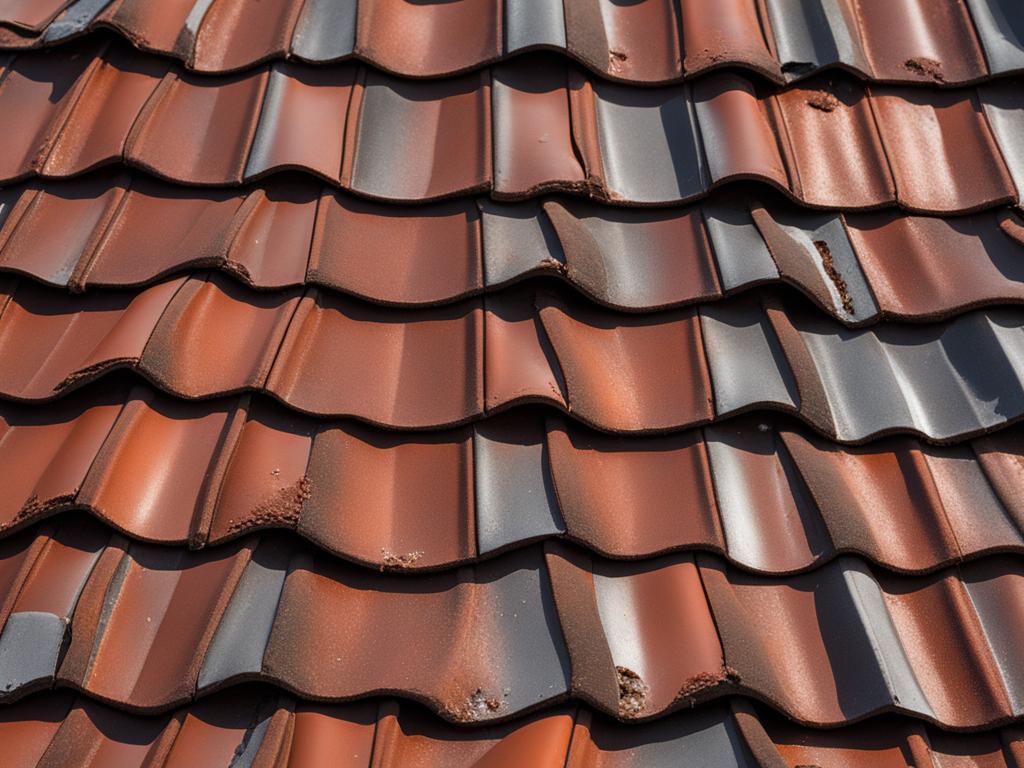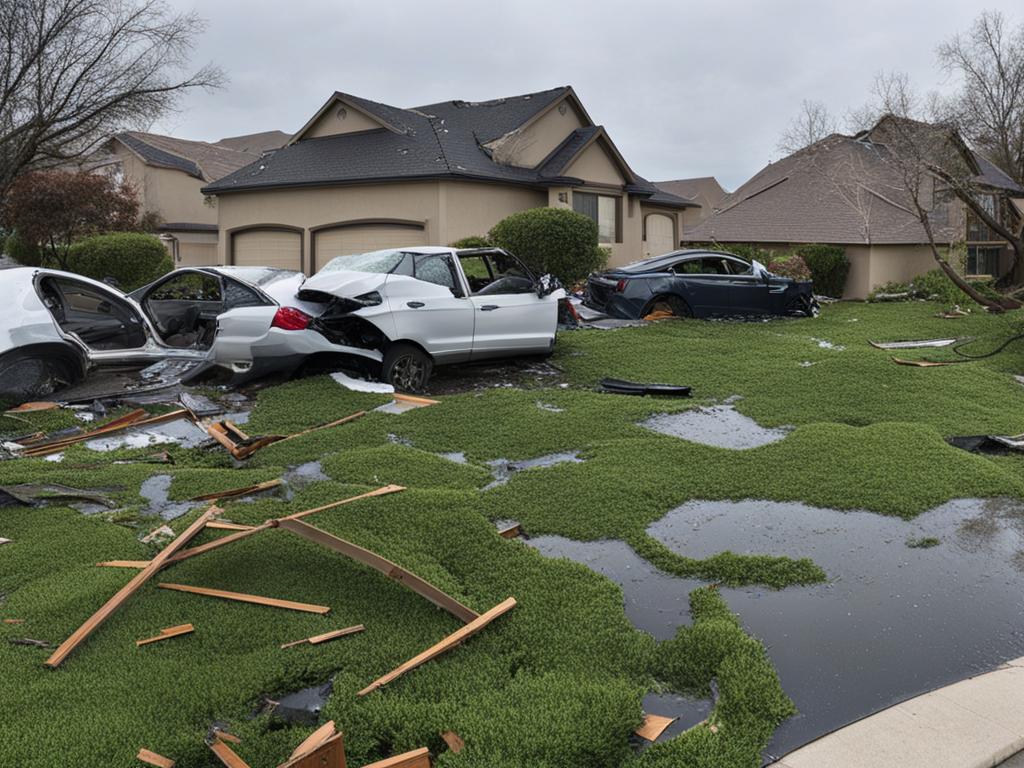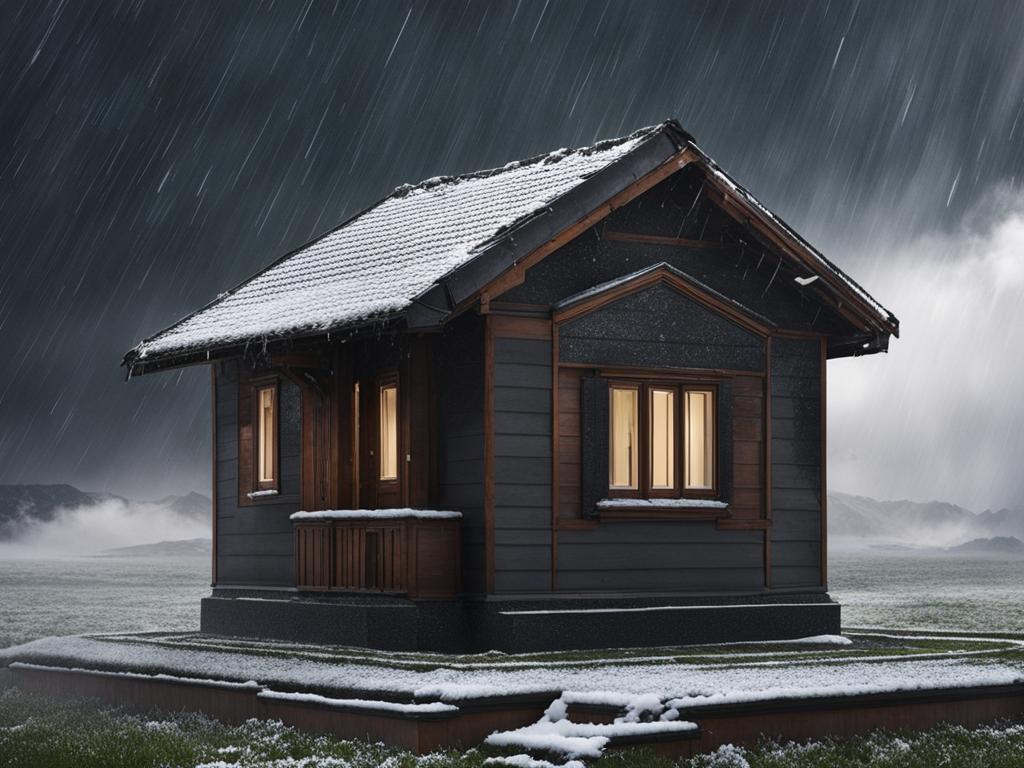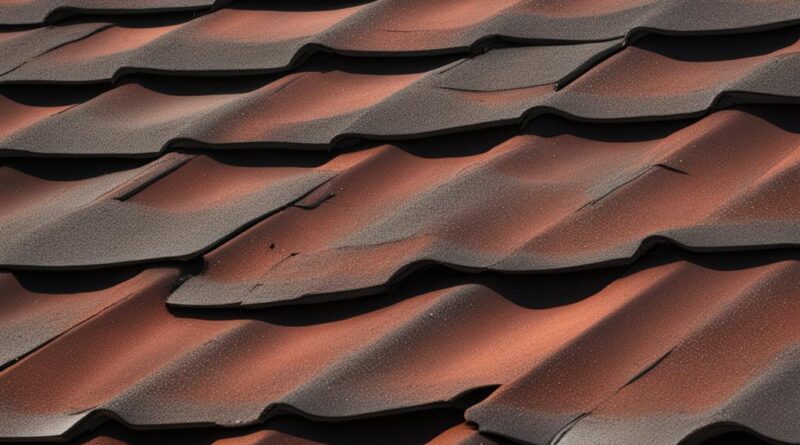Assessing How Much Hail Damage to Replace Roof – Guide
Hail damage to your roof can cause significant issues and may require replacement. Assessing the extent of hail damage requires a thorough roof inspection. Signs of hail damage include shingle damage, dented gutters, dings to garage doors, splatter marks on AC units, dents on cars, exposed or fractured fiberglass mat, damage to painted surfaces, granule loss from asphalt shingles, damaged window sills, exposed metal surfaces, damage to decks, leaks, and water stains. Hailstones larger than an inch may cause hail damage. It is recommended to hire a professional roofing contractor to conduct a roof inspection and provide a detailed report with recommendations for repairs or replacement.
Key Takeaways:
- Hail damage can result in significant issues and may require roof replacement.
- Signs of hail damage include shingle damage, dented gutters, and damage to other surfaces.
- Hailstones larger than an inch may cause hail damage.
- A professional roof inspection is recommended to assess the extent of hail damage.
- It is important to hire a reputable roofing contractor for accurate assessments and recommendations.
Signs of Hail Damage to Look Out For
When assessing the impact of a hailstorm on your roof, it’s important to know the signs of hail damage to look out for. Identifying these signs early on can help you take prompt action and prevent further damage. Here are some key indicators of hail damage:
- Shingle damage: Look for tears, fractures, punctures, or flaking off of granules on your shingles.
- Dents on surfaces: Check for dents on metal surfaces such as gutters, downspouts, and air conditioning units.
- Granules in gutters or downspouts: Check your gutters and downspouts for a buildup of granules, which may indicate hail impact.
- Large dents on the roof: Significant hailstones can cause noticeable dents on the roof surface.
If you observe any of these signs, it’s advisable to schedule a professional roof inspection to assess the extent of the hail damage and determine the necessary repairs or replacement.
Hail Size and its Impact
The size of hailstones is an important factor in understanding the potential impact on your roof. Hailstones smaller than an inch in diameter may not cause significant hail damage. However, hailstones the size of a quarter or larger can result in more severe damage, including shingle fractures, punctures, or tears.
To better evaluate the size of hailstones, you can refer to the National Weather Service’s Hail Size Comparison Chart:
| Hailstone Size | Damage Potential |
|---|---|
| 1/4 inch | Minimal damage |
| 1/2 inch | Minor roof and siding damage possible |
| 1 inch | Significant roof and siding damage likely |
| 1.5 inch | Severe roof and siding damage possible |
| 1.75 inch | Widespread roof and siding damage possible |
| 2 inch | Extensive roof and siding damage likely |
If you experience a hailstorm with hailstones the size of a quarter or larger, it’s highly recommended to schedule a roof inspection to assess any potential hail damage.
Importance of Professional Roof Inspection
When it comes to assessing hail damage and determining the necessary repairs or replacement for your roof, a professional roof inspection is of paramount importance. Roofing contractors have the expertise and knowledge to thoroughly examine the condition of your roof, including the shingles, flashing, and other components.
By hiring a reputable roofing contractor to conduct a roof inspection, you can ensure that any potential hail damage is accurately assessed. They will provide you with a detailed report that includes recommendations for repairs and an estimate of the cost involved. This information is invaluable in making informed decisions about the necessary steps to take.
It is highly recommended that you choose a roofing contractor with a good reputation. You can do this by checking online reviews, seeking recommendations from friends and family, and verifying their Better Business Bureau ratings. This will help ensure that you hire a professional who will provide an honest assessment of your roof’s condition.
One of the primary benefits of a professional roof inspection is that it can uncover any unseen damage that may not be apparent to the untrained eye. This includes hidden leaks, compromised structural integrity, or other issues that could potentially worsen over time if left unaddressed. By identifying these problems early on, you can take the necessary steps to prevent further damage and potentially save yourself from more costly repairs down the line.
Overall, a professional roof inspection is an essential part of assessing hail damage to your roof. It provides you with an accurate assessment of the extent of the damage and helps you understand whether a repair or replacement is necessary. By taking the time to hire a reputable roofing contractor and scheduling a thorough inspection, you can ensure the long-term integrity and protection of your home.
The Cost of Roof Inspection
When it comes to assessing hail damage and determining the necessary repairs or replacement for your roof, a professional inspection is essential. However, many homeowners may be concerned about the cost of this service. The cost of a roof inspection can vary depending on the roofing contractor you choose. Some contractors offer free inspections, while others may charge an average of $200 for their services.
To save money on roof inspections, it is advisable to inquire about the cost before hiring a roofing contractor. Look for roofing companies that offer free inspections to avoid any additional expenses. Additionally, getting multiple inspections can be beneficial as it helps ensure an accurate assessment of the hail damage. By comparing the recommendations and estimates from different contractors, homeowners can make informed decisions and potentially save money in the long run.
| Roof Inspection Cost | Roofing Contractor | Multiple Inspections |
|---|---|---|
| Varies | Depends on the contractor | Recommended for accurate assessment |
| Some offer free inspections | Charge an average of $200 | Compare recommendations and estimates |
While the cost of a roof inspection may be a concern, it is important to consider it as a worthwhile investment. A professional inspection will help determine the extent of the hail damage and whether a repair or replacement is needed. By addressing the damage promptly, homeowners can avoid more costly issues in the future and ensure the longevity of their roof.
Repair or Replacement: Assessing Hail Damage
When it comes to hail damage, determining whether repairs or a full roof replacement is necessary depends on the severity of the damage. Minor hail damage, such as dents or granule loss, may only require repairs to restore the roof’s functionality and appearance. However, significant hail damage, including roof leaks, holes, and large dents, may warrant a full roof replacement to ensure the long-term integrity of the structure.
A professional assessment from a reputable roofing contractor is essential in accurately evaluating the extent of the hail damage. These professionals have the expertise and experience to thoroughly inspect the roof and provide an informed recommendation regarding the appropriate course of action. They will consider factors such as the overall condition of the roof, the age of the shingles, and the extent of the damage to make an informed assessment.
It is important to contact your homeowners insurance company if a roof replacement is necessary. This allows you to file an insurance claim and potentially receive financial assistance for the cost of the replacement. Your insurance policy may cover hail damage, but it’s crucial to review the policy’s coverage and understand the claim process to ensure a smooth and successful claim.

Table: Repair or Replacement Criteria for Hail Damage
| Severity of Hail Damage | Recommended Action |
|---|---|
| Minor damage with dents or granule loss | Repairs to restore functionality and appearance |
| Significant damage with roof leaks, holes, and large dents | Full roof replacement for long-term integrity |
Assessing hail damage requires a professional evaluation to ensure the appropriate steps are taken to address the damage. By working with a reputable roofing contractor and following the guidance of your insurance company, you can navigate the process of repairing or replacing your roof with confidence and peace of mind.
Dealing with Insurance Claims for Hail Damage
Filing an insurance claim for hail damage is an important step in addressing the costs of repairs or replacements. To begin the process, homeowners should review their homeowners insurance coverage to ensure it covers hail damage. It is crucial to document the hail damage thoroughly through photos, videos, and written descriptions. This documentation will serve as evidence when filing the claim and can help support the need for repairs or replacements.
Getting a quote from a professional roofing contractor is highly recommended when filing an insurance claim for hail damage. The quote will provide an estimate of the costs involved in the repairs or replacements, which will be required by the insurance company for claim processing. Additionally, homeowners should familiarize themselves with the claim process and the specific procedures outlined by their insurance company. Following these procedures correctly and submitting the claim on time can increase the chances of a successful claim settlement.
| Steps for Dealing with Insurance Claims for Hail Damage |
|---|
| 1. Review homeowners insurance coverage to ensure it covers hail damage. |
| 2. Document the hail damage through photos, videos, and written descriptions. |
| 3. Get a quote from a professional roofing contractor for the repairs or replacements. |
| 4. Familiarize yourself with the insurance company’s claim process and follow the correct procedures. |
| 5. Submit the claim on time to increase chances of a successful claim settlement. |
By following these steps, homeowners can navigate the insurance claim process effectively and increase their chances of receiving financial assistance for hail damage-related repairs or replacements. It is important to remember that not all insurance policies cover hail damage, so homeowners should review their policy carefully or consult with their insurance agent to determine the coverage available.
Understanding the Formation and Size of Hailstones
When it comes to assessing hail damage, understanding the formation and size of hailstones is crucial. Hailstones are formed when drops of water freeze together in thunderstorm clouds. They can range in size from 5 millimeters to 15 centimeters in diameter and may have round or irregular shapes. During a hailstorm, hailstones fall to the ground at speeds between 25 and 40 miles per hour. Larger hailstones can cause more severe damage to roofs and other property.

In order to accurately assess the potential impact on a roof and determine the extent of hail damage, it is important to consider the size of hailstones. Hailstones smaller than an inch may not cause significant damage, while hailstones the size of a quarter or larger can result in more severe damage. By understanding the formation and size of hailstones, homeowners and roofing professionals can better assess the potential impact on a roof and determine the appropriate course of action.
While hail damage can vary depending on the size of the hailstones, it is important to note that even smaller hailstones can cause damage over time. The repeated impact of small hailstones can lead to the degradation of shingles, exposure of underlying materials, and potential water damage. Therefore, it is essential to address hail damage promptly and thoroughly assess the extent of the damage, regardless of the size of the hailstones.
Assessing Hail Damage to Shingle Roofing
When it comes to assessing hail damage to shingle roofing, there are two classifications to consider: latent damage and severe damage. Latent damage occurs when hailstones impact the shingles, removing the protective granules and exposing the underlying asphalt to UV light. Over time, this can lead to accelerated deterioration. On the other hand, severe damage occurs when hailstones puncture, fracture, or tear the shingles, resulting in more extensive and noticeable destruction.
To accurately assess hail damage to shingle roofs, professional roof inspections are recommended. These inspections involve a thorough examination of the roof’s condition, including the shingles, flashing, and other components. Roof plans and general on-site observations are also important in documenting hail distress. By conducting a professional assessment, homeowners can gain a comprehensive understanding of the scope of repairs required.
| Hail Damage Classification | Description |
|---|---|
| Latent Damage | Removal of protective granules, exposing underlying asphalt to UV light |
| Severe Damage | Punctured, fractured, or torn shingles |
It’s important to note that certain factors can increase the susceptibility of shingle roofing to hail damage. Shingles that overlay a previous roof, as well as those with inadequate ventilation or material deficiencies, are more prone to hail damage. By understanding the classification of hail damage and the factors that contribute to its severity, homeowners can make informed decisions regarding necessary repairs or replacements.
Typical Hail Damage to Shingle Roofs
When it comes to shingle roofs, hail damage can manifest in various ways. One common sign of hail impact is circular areas of granule loss on the shingles. As the granules flake off, the underlying roofing material becomes exposed, making it more susceptible to water damage and leaks. Additionally, hailstones can cause dents and indentations on the shingles, compromising their structural integrity over time. This can lead to loose asphalt and increased vulnerability to UV damage. Furthermore, water damage resulting from hail damage can contribute to mold growth and higher electricity bills. It is crucial to address hail damage promptly to prevent further issues and expenses.
Here is a detailed breakdown of the typical hail damage that can occur on shingle roofs:
| Hail Damage | Description |
|---|---|
| Circular areas of granule loss | Hail impact can strip away the protective granules from the shingles, exposing the underlying material to UV light and accelerating deterioration. |
| Dents and indentations | Hailstones can create noticeable dents and indentations on the shingles, compromising their structural integrity. |
| Exposed asphalt | As the granules flake off, the asphalt becomes loose and vulnerable to UV damage. |
| Water damage and leaks | Hail damage can lead to water infiltration, resulting in potential mold growth and increased electricity bills. |
Understanding these typical forms of hail damage can help homeowners identify and address issues promptly. By taking immediate action and consulting with a professional roofing contractor, homeowners can mitigate the long-term consequences of hail damage.
Importance of Immediate Inspection and Documentation
After a hailstorm, it is crucial to schedule a roof inspection to assess the extent of the damage. Immediate inspection allows for timely repairs or replacements before further damage occurs. It is recommended to document all the hail damage through photos and videos. This includes damage to the roof, gutters, pipes, siding, vehicles, windows, and interior damage. Taking steps to prevent further damage, such as tarping the roof and saving receipts for repair expenses, is essential. Familiarizing yourself with the insurance policy’s coverage for hail damage can help expedite the claim process.

During the inspection, a professional roofing contractor will assess the severity of the hail damage and provide an accurate evaluation. This evaluation will aid in determining the necessary repairs or replacements. It is important to hire a reputable roofing contractor who has experience with hailstorm damage. They can provide expert recommendations and guide you through the process of filing an insurance claim, if necessary.
Importance of Documentation
Documenting the hail damage is crucial for insurance purposes. It serves as evidence of the extent of the damage that occurred during the hailstorm. Photos and videos should be taken from multiple angles and include any visible damage. The documentation should also include written descriptions of the damage to provide additional clarity.
It is important to note that insurance companies may require documentation of the hailstorm damage to process your claim. Providing thorough documentation can help ensure a smoother and faster claim process, allowing you to get the necessary repairs or replacements in a timely manner.
In addition to documenting the hail damage, it is also important to keep records of any repairs or replacements that are done. This includes saving receipts and invoices for materials and labor. These records can help support your insurance claim and ensure that you are properly compensated for the expenses incurred due to the hailstorm damage.
| Importance of Immediate Inspection and Documentation |
|---|
| 1. Schedule a roof inspection promptly after a hailstorm. |
| 2. Document all hail damage through photos and videos. |
| 3. Take steps to prevent further damage and save repair receipts. |
| 4. Familiarize yourself with your insurance policy’s coverage for hail damage. |
| 5. Hire a reputable roofing contractor for the inspection and repairs. |
| 6. Thoroughly document the hail damage through multiple angles and written descriptions. |
| 7. Keep records of all repairs and replacements done. |
Tips to Reduce Hail Damage and Minimize Costs
When it comes to protecting your home from hail damage, taking proactive measures can make a significant difference. By implementing the following tips, you can reduce the risk of damage and minimize the associated costs:
- Install Impact-Resistant Materials: Consider using impact-resistant roofing materials, such as metal roofing or asphalt shingles with a Class 4 impact rating. These materials are designed to withstand hailstones and can provide added protection to your roof.
- Trim Trees: Regularly trim trees and branches around your property to prevent them from falling onto your roof during a hailstorm. This will help minimize the potential for hail damage caused by falling debris.
- Secure Loose Objects: Take the time to secure loose objects in your yard, such as patio furniture, plant pots, and other outdoor items. Hailstorms can produce strong winds, causing these objects to become projectiles that can damage your roof.
- Consult with Roofing Professionals: Reach out to roofing professionals to discuss additional protective measures you can take to reduce hail damage. They can provide expert advice tailored to your specific roofing needs.
By implementing these tips, you can help safeguard your home against hail damage and minimize the potential costs associated with repairs or replacements. Remember, taking proactive measures is always more cost-effective than dealing with the aftermath of a severe hailstorm.

Table: Impact-Resistant Roofing Materials
| Roofing Material | Key Features |
|---|---|
| Metal Roofing | Durable, long-lasting, and highly resistant to hail impact. Can withstand large hailstones without sustaining significant damage. |
| Class 4 Asphalt Shingles | Designed with reinforced layers to enhance impact resistance. Can withstand hailstones of various sizes. |
| Slate Roofing | Naturally resistant to hail damage due to its dense and durable composition. Ideal for areas prone to severe hailstorms. |
| Concrete Roof Tiles | Strong and durable, providing excellent protection against hail. Can withstand hailstones of varying sizes. |
Installing impact-resistant roofing materials is an investment that can pay off in the long run, as it can significantly reduce the risk of hail damage and minimize potential repair costs. Consult with a roofing professional to determine which material is best suited for your home.
Conclusion
The impact of hail damage on roofs can be significant, often requiring replacement rather than just repairs. Properly assessing the extent of hail damage is essential to determine the necessary course of action. Consulting a professional roofing contractor is recommended for a thorough roof inspection and detailed report, including recommendations for repairs or replacement.
Insurance claims play a crucial role in mitigating the costs of hail damage and roof replacement. Documenting the hail damage through photos, videos, and written descriptions is vital in the claims process. Understanding the homeowner’s insurance coverage and following the proper procedures for filing a claim can increase the chances of receiving financial assistance.
When faced with hail damage, prompt action is key. Scheduling an immediate roof inspection, documenting the damage, and taking steps to prevent further damage are all essential. By doing so, homeowners can address the hail damage effectively, minimize repair costs, and ensure the longevity and safety of their roof.
FAQ
What are the signs of hail damage to look out for?
Signs of hail damage include shingle damage, dented gutters, dings to garage doors, splatter marks on AC units, dents on cars, exposed or fractured fiberglass mat, damage to painted surfaces, granule loss from asphalt shingles, damaged window sills, exposed metal surfaces, damage to decks, leaks, and water stains.
How do I assess hail damage to my roof?
Assessing hail damage requires a thorough roof inspection by a professional roofing contractor. They will examine the condition of the shingles, flashing, and other components of the roof to determine the extent of the damage. It is recommended to hire a professional for an accurate assessment.
What size of hail can cause damage to my roof?
Hailstones larger than an inch, or about the size of a quarter, can cause significant damage to a roof. If hailstones of this size are present, it is recommended to schedule a roof inspection to assess the damage.
Why is a professional roof inspection important for assessing hail damage?
A professional roof inspection is crucial in accurately assessing hail damage and determining the necessary repairs or replacement. Roofing contractors have the expertise to thoroughly examine the condition of the roof and provide a detailed report with recommendations for repairs or replacement.
How much does a roof inspection cost?
The cost of a roof inspection can vary depending on the roofing contractor. Some contractors offer free inspections, while others may charge an average of $200. It is advisable to inquire about the cost before hiring a roofing contractor.
How do I decide between repair or replacement for hail damage?
The decision between repair or replacement depends on the severity of the hail damage. Minor hail damage may only require repairs, while significant damage may necessitate a full roof replacement. A professional assessment from a roofing contractor will provide guidance on the appropriate course of action.
How do I file an insurance claim for hail damage?
To file an insurance claim for hail damage, review your homeowners insurance coverage to ensure it covers hail damage. Document the hail damage through photos, videos, and written descriptions. Getting a quote from a professional roofing contractor is also recommended. File the claim on time and follow the proper procedures outlined by your insurance company.
How are hailstones formed and what sizes can they reach?
Hailstones are formed when drops of water freeze together in thunderstorm clouds. They can range in size from 5 millimeters to 15 centimeters in diameter and may have round or irregular shapes. Larger hailstones can cause more severe damage to roofs and other property.
What are the typical signs of hail damage to shingle roofing?
Hail damage to shingle roofing can result in circular areas of granule loss, dents, indentations, and structural issues. Granule loss exposes the underlying asphalt, leading to potential water damage and leaks. Professional roof inspections can determine the scope of repairs needed.
Why is immediate inspection and documentation important after a hailstorm?
Immediate inspection allows for timely repairs or replacements before further damage occurs. Documenting all hail damage through photos and videos helps with insurance claims and provides evidence of the extent of the damage.
How can I reduce hail damage and minimize repair costs?
Homeowners can take proactive measures to reduce hail damage, such as regular roof maintenance, installing impact-resistant roofing materials, trimming trees and branches, and installing protective shields. Consulting with roofing professionals for additional protective measures can also help reduce the risk of hail damage.

